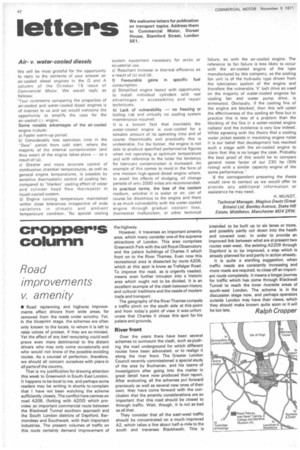cropper's column
Page 44

If you've noticed an error in this article please click here to report it so we can fix it.
Road improvements v. amenity
• Road replanning and highway improvements affect drivers from wide areas, far removed from the roads under scrutiny. Yet, in the blueprint stage, the schemes are often only known to the locals, to whom it is left to raise voices of protest, if they are so minded. Yet the effect of any bad rerouteing could well prove even more detrimental to the distant drivers who may only come occasionally and who would not know of the possible avoiding routes. As a counsel of perfection, therefore, we should all concern ourselves with plans in all parts of the country.
That is my justification for drawing attention this week to Greenwich in South-East London. It happens to be local to me, and perhaps some readers may be writing in shortly to complain that I have not been watching the scheme sufficiently closely. The conflict here centres on road A206, (forking with A200) which provides an important commercial route between the Blackwell Tunnel southern approach and the South London districts of Deptford. Bermondsey and Southwark, with their important industries. The present volumes of traffic on this route certainly demand improvement of
the highway.
However, it traverses an important amenity area. which many consider one of the supreme attractions of London. This area comprises Greenwich Park with the old Royal Observatory and the palace buildings of Charles II which front on to the River Thames. Even now this recreational area is dissected by route A206. which at this spot is know as Trafalgar Road. To improve the road, as is urgently needed, means even further intrusion into a historic area which ought not to be divided. It is an excellent example of the clash between history and cultural traditions and the needs of modern trade and transport.
The geography of the River Thames compels a traffic pinch on the south side at this point and from today's point of view it was unfortunate that Charles II chose this spot for his palace and grounds.
River front
Over the years there have been several schemes to surmount the clash, such as pushing the road underground for which different routes have been advocated, or to realign it along the river front. The Greater London Council recently commissioned a special study of the area by Buchanan, and his teams of investigators after going into the matter in great detail have now produced their report. After evaluating all the schemes put forward previously as well as several new ones of their own, they have come forward with the conclusion that the amenity considerations are so important that this road should be closed to through traffic. Wait, though, it is not as bad as all that.
They consider that all the cast-west traffic should be concentrated on a much improved A2, which takes a line about half-a-mile to the south and traverses Blackheath. This is intended to be built up to six lanes or more, and possibly partly cut down into the heath and covered over. In order to provide an improved link between what are at present two routes east-west, the existing A2209 through Deptford is to be improved, a step which is already planned for and partly in action already.
It is quite a startling suggestion, when traffic needs are constantly increasing and more roads are required, to close off an important route completely. It means a longer journey for traffic which has come through Blackwall Tunnel to reach the inner riverside areas of south-east London. The scheme is in the discussion stage now, and perhaps operators outside London may have their views, which they should make known quite soon or it will
be too late. Ralph Cropper




































































































































































